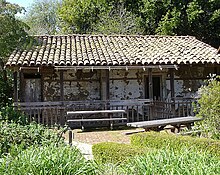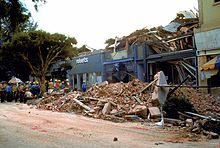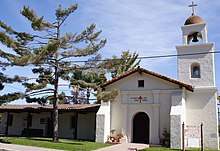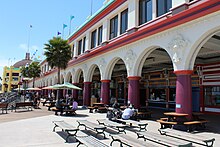
A | B | C | D | E | F | G | H | CH | I | J | K | L | M | N | O | P | Q | R | S | T | U | V | W | X | Y | Z | 0 | 1 | 2 | 3 | 4 | 5 | 6 | 7 | 8 | 9
Santa Cruz | |
|---|---|
| City of Santa Cruz | |
View of downtown Santa Cruz Mission Santa Cruz replica Santa Cruz coastline The historic post office Downtown Santa Cruz | |
| Nickname: Surf City[1] | |
| Coordinates: 36°58′19″N 122°1′35″W / 36.97194°N 122.02639°W | |
| Country | United States |
| State | California |
| County | Santa Cruz |
| Mission | September 25, 1791[2] |
| Incorporated | March 31, 1866[3] |
| Chartered | April 1876[4] |
| Government | |
| • Type | Council/Manager[4] |
| • Mayor | Sonja Brunner[5] |
| • State senator | John Laird (D)[6] |
| • Assemblymember | Robert Rivas (D)[6] |
| • U. S. Rep. | Jimmy Panetta (D)[7] |
| Area | |
| • City | 15.83 sq mi (41.00 km2) |
| • Land | 12.74 sq mi (33.00 km2) |
| • Water | 3.09 sq mi (8.00 km2) 19.51% |
| • Urban | 58.4 sq mi (151.1 km2) |
| • Metro | 607 sq mi (1,570 km2) |
| Elevation | 36 ft (11 m) |
| Population | |
| • City | 62,956 |
| • Estimate (2022)[11] | 64,075 |
| • Density | 4,000/sq mi (1,500/km2) |
| • Urban | 163,703 |
| • Metro | 262,382 |
| Time zone | UTC−8 (Pacific) |
| • Summer (DST) | UTC−7 (PDT) |
| ZIP codes[14] | 95060–95067 |
| Area code | 831 |
| FIPS code | 06-69112 |
| GNIS feature IDs | 1659596, 2411820 |
| Website | cityofsantacruz.com |
Santa Cruz (Spanish for "Holy Cross") is the largest city and the county seat of Santa Cruz County, in Northern California. As of the 2020 census, the city population was 62,956.[10] Situated on the northern edge of Monterey Bay, Santa Cruz is a popular tourist destination, owing to its beaches, surf culture, and historic landmarks.
Santa Cruz was founded by the Spanish in 1791, when Fermín de Lasuén established Mission Santa Cruz. Soon after, a settlement grew up near the mission called Branciforte, which came to be known across Alta California for its lawlessness. With the Mexican secularization of the Californian missions in 1833, the former mission was divided and granted as rancho grants. Following the American Conquest of California and the admission of California as a U. S. state in 1850, Santa Cruz was incorporated as a town in 1866, and became a charter city in 1876. The creation of the Santa Cruz Beach Boardwalk in 1904 solidified the city's status as a seaside resort community, while the establishment of the University of California, Santa Cruz in 1965 made Santa Cruz a college town.
History

Indigenous period
Indigenous people have been living in the Santa Cruz region for at least 12,000 years.[15] Prior to the arrival of Spanish soldiers, missionaries and colonists in the late 18th century, the area was home to the Awaswas nation of Ohlone people, who lived in a territory stretching slightly north of Davenport to Rio Del Mar. The Awaswas tribe was made up of no more than one thousand people and their language is now extinct. The only remnants of their spoken language are three local place names: Aptos, Soquel and Zayante; and the name of a native shellfish – abalone. At the time of colonization, the Indigenous people belonged to the Uypi tribe of the Awaswas-speaking dialectical group. They called the area Aulinta.[16]
Spanish period
The first European land exploration of Alta California, the Spanish Portolá expedition led by Gaspar de Portolá, passed through the area on its way north, still searching for the "port of Monterey" described by Sebastian Vizcaino in 1602. The party forded the river (probably near where the Soquel Avenue bridge now stands) and camped nearby on October 17, 1769. Franciscan missionary Juan Crespí, traveling with the expedition, noted in his diary that, "This river was named San Lorenzo." (for Saint Lawrence).
Next morning, the expedition set out again, and Crespi noted that, "Five hundred steps after we started we crossed a good arroyo of running water which descends from some high hills where it rises. It was named "El Arroyo de la Santisima Cruz, which translates literally as "The Stream of the Most Holy Cross".[17]
In 1791, Father Fermín Lasuén continued the use of Crespi's name when he declared the establishment of La Misión de la Exaltación de la Santa Cruz (also known as Mission Santa Cruz) for the conversion of the Awaswas of Chatu-Mu and surrounding Ohlone villages. Santa Cruz was the twelfth mission to be founded in California. The creek, however, later lost the name, and is known today as Laurel Creek because it parallels Laurel Street. It is the main feeder of Neary Lagoon.[18]
In 1797, Governor Diego de Borica, by order of the Viceroy of New Spain, Miguel de la Grúa Talamanca y Branciforte, marqués de Branciforte, established the Villa de Branciforte, a town named in honor of the Viceroy.[19] One of only three civilian towns established in California during the Spanish colonial period (the other two became Los Angeles and San Jose), the Villa was located across the San Lorenzo River, less than a mile from the Mission. Its original main street is now North Branciforte Avenue. Villa de Branciforte later lost its civic status, and in 1905 the area was annexed into the City of Santa Cruz.
Mexican period

In the 1820s, newly independent Mexico assumed control of the area.[20] Following the Mexican secularization act of 1833, governor Figueroa attempted to rename the community that had grown up around the mission after himself, to Pueblo de Figueroa. The pueblo designation was never made official, however. The new name did not catch on and Santa Cruz remained Santa Cruz.
The Santa Cruz mission, along with the rest of the twenty-one Alta California missions, was secularized within a few years after 1833. Even before secularization, the Native American population had declined. Following secularization, mission grazing lands, which once extended from the San Lorenzo River north along the coast to approximately today's Santa Cruz County border, were taken away and broken up into large land grants called ranchos. The grants were made by several different governors between 1834 and 1845 (see List of Ranchos of California).
Two ranchos were totally within the boundaries of today's city of Santa Cruz. Rancho Potrero Y Rincon de San Pedro Regalado consisted mostly of flat, river-bottom pasture land north of Mission Hill ("potrero" translates as "pasture"). Rancho Tres Ojos de Agua was on the west side. Three other rancho boundaries later became part of the modern city limits: Rancho Refugio on the west. Rancho Carbonera on the north, and Rancho Arroyo del Rodeo on the east.

After secularization put most California land into private hands, immigrants from the United States began to arrive in steadily increasing numbers, especially in the 1840s when overland routes like the California Trail were opened. In 1848, following the Mexican–American War, Mexico ceded the territory of Alta California to the U.S. in the Treaty of Guadalupe Hidalgo.
Demoted to a parish church, the former Santa Cruz mission was unable to maintain its building complex after secularization, and the adobe buildings slowly began to fall apart from wet weather and lack of maintenance. The chapel tower fell in 1840 and the entire front wall was destroyed in the 1857 Fort Tejon earthquake. In 1858 a "modern" church was built next door to the remaining rear portion of the chapel. That remainder was demolished in 1889, when today's Holy Cross church was built on the site, in a gothic style.
American period

California was the first portion of the former Mexican territory to become a state, in 1850. Santa Cruz County was established the same year, and Santa Cruz became the county seat. Santa Cruz was incorporated as a town in 1866, and became a charter city in 1876.
Following the U.S. Conquest of California, Santa Cruz steadily grew with the arrival of immigrants from the eastern United States. Elihu Anthony (1818–1905) arrived in Santa Cruz in 1847[21] and opened many firsts for the city, including the first Protestant Church and the first blacksmith foundry. He built the first wharf and was the first postmaster.[21] He developed the first commercial blocks in downtown Santa Cruz with his early blacksmith foundry located at what is now the corner of Pacific Avenue and Mission Street.[21] With Frederick A. Hihn, Anthony built the first private water supply network in the city and serving nearby communities.[22]
The establishment of railroad lines in Santa Cruz in 1875–76 with the Santa Cruz & Felton Railroad and the Santa Cruz Railroad provided market access for the city's timber, leather and limestone industries.[23]

California Powder Works began manufacturing blasting powder for California mining when normal supplies were interrupted by the American Civil War. The extensive complex built on the San Lorenzo River upstream of Santa Cruz used charcoal and powder kegs manufactured from local forests. The Works later manufactured smokeless powder used in United States Army Krag-Jørgensen rifles and guns of the United States Navy Pacific and Asiatic fleets.[24]
Santa Cruz was hard hit by the 1989 Loma Prieta earthquake that killed three people.[25] It was also hit by ocean surges caused by the 2011 Tōhoku earthquake and tsunami, wherein the Santa Cruz Small Craft Harbor sustained an estimated $10 million of damage, with another $5 million of damage to docked boats there.[26] Following the earthquake, a former building chief urged the city government to consider relocating to a safer location with lower risk of damage from seismic activity.[27] It was again hit by ocean surges caused by 2022 Hunga Tonga–Hunga Ha'apai eruption and tsunami, that caused damages to the harbor.[28]

Santa Cruz became one of the first cities to approve marijuana for medicinal uses. In 1992, residents overwhelmingly approved Measure A,[29][30] which allowed for the medicinal uses of marijuana. Santa Cruz was home to the second above-ground medical marijuana club in the world when the Santa Cruz Cannabis Buyers Club opened its doors in April 1995. Santa Cruz also became one of the first cities in California to test the state's medical marijuana laws in court after the arrest of Valerie Corral and Mike Corral, founders of the Wo/Men's Alliance for Medical Marijuana, by the DEA.[31] In January 2020, Santa Cruz became the third city in the US and second city in California to decriminalize psilocybin mushrooms in addition to a slew of other entheogenic plants on the Federal Schedule 1 Substance List.[32]
In 1998, the Santa Cruz community declared itself a nuclear-free zone,[33] and in 2003, the Santa Cruz City Council became the first city council in the U.S. to denounce the Iraq War.[34] The City Council of Santa Cruz also issued a proclamation opposing the USA PATRIOT Act.[35]
Notable feminist activists Nikki Craft and Ann Simonton resided in Santa Cruz, where they formed the "Praying Mantis Brigade". This collection of activists organized the "Myth California Pageant" in the 1980s protesting the objectification of women.[36][37] Myth California was staged concurrently with the Miss California pageant held in Santa Cruz since the 1920s. The protests ran for nine years and eventually contributed to the Miss California pageant leaving Santa Cruz.[38]

Riots occurred on May 1, 2010, sparked when anarchist extremists threw paint at police cars and painted anarchist symbols and anti-capitalist phrases onto buildings, resulting in more than a dozen buildings being vandalized and numerous storefronts being damaged.[39] Property damages are estimated to top roughly $100,000. Prior to the riot, a May Day rally was being held for worker and immigrant rights.[40] According to police, the rally was infiltrated by a local anarchists group, who used the rally as a cover for attacking corporate premises.
Occupy Santa Cruz formed as an autonomous organization in solidarity with the worldwide Occupy movement, a broad-based protest against economic and social inequality. The organization gained most of its notoriety when members barricaded themselves in an empty bank building owned by Wells Fargo[41] and occupied the building for 72 hours, causing $30,000 in damages.[42][43] Eleven criminal charges were filed, at least seven of which have since been dropped.[42]
Geography

Santa Cruz is on the northern edge of Monterey Bay. The area is losing several feet of beach a year.[44]
According to the United States Census Bureau, the city covers an area of 15.8 square miles (41 km2), of which 12.7 square miles (33 km2) is land, and 3.1 square miles (8.0 km2) (19.51%s) is water. To Santa Cruz locals the area is often discussed in terms of distinct regions: east side and west side.
Neighborhoods
The "westside" of Santa Cruz is commonly accepted to be anything west of the San Lorenzo River and the "eastside" east of the San Lorenzo River all the way to neighboring towns of Soquel and Capitola. And the beginning of Aptos is seen as the end boundary for the "eastside".
Climate
Santa Cruz has mild weather throughout the year, experiencing a warm-summer Mediterranean climate characterized by mild, wet winters and warm, mostly dry summers. Due to its proximity to Monterey Bay, fog and low overcast are common during the night and morning hours, especially in the summer. Santa Cruz frequently experiences an Indian summer, with the year's warmest temperatures often occurring in the autumn. Since the city faces south rather than west with mountains to its north, temperatures are usually several degrees warmer than in coastal areas to its northwest.
| Climate data for Santa Cruz, California (1991–2020 normals, extremes 1893–present) | |||||||||||||
|---|---|---|---|---|---|---|---|---|---|---|---|---|---|
| Month | Jan | Feb | Mar | Apr | May | Jun | Jul | Aug | Sep | Oct | Nov | Dec | Year |
| Record high °F (°C) | 84 (29) |
89 (32) |
90 (32) |
97 (36) |
100 (38) |
106 (41) |
105 (41) |
108 (42) |
110 (43) |
103 (39) |
92 (33) |
87 (31) |
110 (43) |
| Mean maximum °F (°C) | 73.2 (22.9) |
75.2 (24.0) |
78.0 (25.6) |
82.9 (28.3) |
84.5 (29.2) |
87.2 (30.7) |
85.7 (29.8) |
88.3 (31.3) |
92.6 (33.7) |
89.8 (32.1) |
79.4 (26.3) |
70.8 (21.6) |
96.2 (35.7) |
| Mean daily maximum °F (°C) | 62.5 (16.9) |
63.9 (17.7) |
66.5 (19.2) |
69.3 (20.7) |
71.4 (21.9) |
74.0 (23.3) |
74.3 (23.5) |
75.8 (24.3) |
76.7 (24.8) |
73.9 (23.3) |
66.7 (19.3) |
61.5 (16.4) |
69.7 (20.9) |
| Daily mean °F (°C) | 51.9 (11.1) |
53.3 (11.8) |
55.3 (12.9) |
57.5 (14.2) |
60.2 (15.7) |
62.8 (17.1) |
64.3 (17.9) |
65.2 (18.4) |
64.8 (18.2) |
61.7 (16.5) |
55.6 (13.1) |
51.2 (10.7) |
58.7 (14.8) |
| Mean daily minimum °F (°C) | 41.4 (5.2) |
42.7 (5.9) |
44.1 (6.7) |
45.7 (7.6) |
49.0 (9.4) |
51.6 (10.9) |
54.3 (12.4) |
54.6 (12.6) |
52.9 (11.6) |
49.5 (9.7) |
44.4 (6.9) |
40.9 (4.9) |
47.6 (8.7) |
| Mean minimum °F (°C) | 31.9 (−0.1) |
33.6 (0.9) |
35.8 (2.1) |
38.1 (3.4) |
42.5 (5.8) |
45.3 (7.4) |
49.3 (9.6) |
49.2 (9.6) |
46.5 (8.1) |
42.0 (5.6) |
35.5 (1.9) |
31.3 (−0.4) |
29.5 (−1.4) |
| Record low °F (°C) | 20 (−7) |
22 (−6) |
28 (−2) |
29 (−2) |
28 (−2) |
34 (1) |
36 (2) |
38 (3) |
30 (−1) |
20 (−7) |
26 (−3) |
19 (−7) |
19 (−7) |
| Average precipitation inches (mm) | 6.42 (163) |
6.10 (155) |
4.31 (109) |
2.04 (52) |
0.87 (22) |
0.24 (6.1) |
0.01 (0.25) |
0.04 (1.0) |
0.10 (2.5) |
1.32 (34) |
3.17 (81) |
6.01 (153) |
30.63 (778) |
| Average precipitation days | 10.6 | 10.7 | 9.5 | 6.0 | 3.5 | 1.3 | 0.6 | 0.8 | 1.1 | 3.6 | 6.9 | 10.2 | 64.8 |
| Source: NOAA[45][46] | |||||||||||||
Demographics
| Census | Pop. | Note | %± |
|---|---|---|---|
| 1860 | 950 | — | |
| 1870 | 2,561 | 169.6% | |
| 1880 | 3,898 | 52.2% | |
| 1890 | 5,596 | 43.6% | |
| 1900 | 5,659 | 1.1% | |
| 1910 | 11,146 | 97.0% | |
| 1920 | 10,917 | −2.1% | |
| 1930 | 14,395 | 31.9% | |
| 1940 | 16,896 | 17.4% | |
| 1950 | 21,970 | 30.0% | |
| 1960 | 25,596 | 16.5% | |
| 1970 | 32,076 | 25.3% | |
| 1980 | 41,483 | 29.3% | |
| 1990 | 49,040 | 18.2% | |
| 2000 | 54,593 | 11.3% | |
| 2010 | 59,946 | 9.8% | |
| 2020 | 62,956 | 5.0% | |
| U.S. Decennial Census[47] | |||
2000

Recorded from the census of 2000,[48] there were 54,593 people total with 20,442 households and 10,404 families residing in the city. The population density includes 1,682.2/km2 (4,357/sq mi). There were 21,504 housing units at an average density of 1,715.8 units per square mile (662.5 units/km2). The racial makeup of the city was 78.7% White, 17.4% Hispanic or Latino, 1.7% African American, 0.9% Native American, 4.9% Asian, 0.1% Pacific Islander, 9.1% from other races, and 4.5% from two or more races.
There were 20,442 households, out of which 25.1% had children under the age of 18 living with them, 37.0% were married couples living together, 9.6% had a female householder with no husband present, and 49.1% were non-families. 29.3% of all households were made up of individuals, and 7.6% had someone living alone who was 65 years of age or older. The average household size was 2.44 and the average family size was 2.98.
In the city, the age distribution of the population shows 17.3% under the age of 18, 20.5% from 18 to 24, 32.6% from 25 to 44, 21.0% from 45 to 64, and 8.5% who were 65 years of age or older. The median age was 32 years. For every 100 females, there were 99.2 males. For every 100 females age 18 and over, there were 97.9 males age 18 and over.
The median income for a household in the city was $50,605, and the median income for a family was $62,231 (these figures had risen to $59,172 and $80,496 respectively as of a 2007 estimate[49]). Males had a median income of $44,751 versus $32,699 for females. The per capita income for the city was $25,758. About 6.6% of families and 16.5% of the population were below the poverty line, including 12.5% of those under age 18 and 4.8% of those age 65 or over.
2010

The 2010 United States Census[50] reported that Santa Cruz had a population of 59,946. The population density was 3,787.2 inhabitants per square mile (1,462.2/km2). The racial makeup of Santa Cruz was 44,661 (74.5%) White, 1,071 (1.8%) African American, 440 (0.7%) Native American, 4,591 (7.7%) Asian, 108 (0.2%) Pacific Islander, 5,673 (9.5%) from other races, and 3,402 (5.7%) from two or more races. Hispanic or Latino of any race were 11,624 persons (19.4%).
The Census reported that 51,657 people (86.2% of the population) lived in households, 7,910 (13.2%) lived in non-institutionalized group quarters, and 379 (0.6%) were institutionalized.

There were 21,657 households, out of which 4,817 (22.2%) had children under the age of 18 living in them, 7,310 (33.8%) were opposite-sex married couples living together, 1,833 (8.5%) had a female householder with no husband present, 862 (4.0%) had a male householder with no wife present. There were 1,802 (8.3%) unmarried opposite-sex partnerships, and 379 (1.8%) same-sex married couples or partnerships. 6,773 households (31.3%) were made up of individuals, and 1,862 (8.6%) had someone living alone who was 65 years of age or older. The average household size was 2.39. There were 10,005 families (46.2% of all households); the average family size was 2.92.
The age distribution of the population shows 8,196 people (13.7%) under the age of 18, 17,449 people (29.1%) aged 18 to 24, 15,033 people (25.1%) aged 25 to 44, 13,983 people (23.3%) aged 45 to 64, and 5,285 people (8.8%) who were 65 years of age or older. The median age was 29.9 years. For every 100 females, there were 100.5 males. For every 100 females age 18 and over, there were 99.7 males.
Housing and homelessness
By one estimate, Santa Cruz had in 2023 the least affordable rental market in the United States, pushing past San Francisco which was previously the most unaffordable rental market.[51] There were 23,316 housing units at an average density of 1,473.0 units per square mile (568.7 units/km2), of which 9,375 (43.3%) were owner-occupied, and 12,282 (56.7%) were occupied by renters. The homeowner vacancy rate was 1.2%; the rental vacancy rate was 3.4%. 22,861 people (38.1% of the population) lived in owner-occupied housing units and 28,796 people (48.0%) lived in rental housing units. The median price of a home being $640,000 as of April 2013.[52]
Santa Cruz has one of the highest rates of homelessness in the US, with 9,041 estimated homeless in Santa Cruz county in 2011, approximately 3.5% of the total county population.[53] with over 52% of homeless experiencing some form of mental illness, including clinical depression or PTSD and over 26% suffering unspecified mental illness.[53] Additionally, 38% of homeless surveyed in Santa Cruz county in 2011 experienced drug and/or alcohol dependency.[53] In recent years, citizen groups such as Take Back Santa Cruz, established in 2009, have lobbied city government and officials to address what they view as a public safety crisis, a situation that has gathered national attention.[54][55]
Economy

The principal industries of Santa Cruz are agriculture, tourism, education (UC Santa Cruz) and high technology. Santa Cruz is a center of the organic agriculture movement, and many specialty products as well as housing the headquarters of California Certified Organic Farmers.
Tourist attractions include the classic Santa Cruz Beach Boardwalk on the beach, the redwood forests in the Santa Cruz Mountains above the town, and Monterey Bay, which is protected as a marine sanctuary.
Technology companies have made Santa Cruz their home since the 1980s. Examples from that era include the Santa Cruz Operation (later Tarantella, Inc.), Plantronics, and Parallel Computers, Inc.[56]
Downtown Santa Cruz houses a variety of storefronts and businesses. It is also stage to many street performers, musicians, and artists, oftentimes creating the presence of background music and miscellaneous street side entertainment when visiting downtown. Consequently, Pacific Avenue serves as an outlet for the artistic and unique culture[citation needed] that Santa Cruz possesses.
Top employers

As of 2020, the top employers within the city were:[57]













